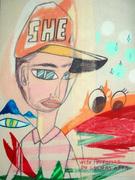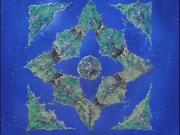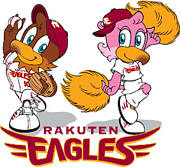古武家賢太郎さんが 10/16〜11/14までロンドンのI-MYU Projectにて初個展をされます。4mの大作も出展されます。ロンドンにおられる方は是非。
I-MYU Project
http://
1st fl. 23 Charlotte Road
London EC2A 3PB
find in google map
Contact detail
U.K Phone : +442070334480
Fax : +442080825876
Email : imyuprojects@gmail.com
Opening times
Tuseday - Saturday: 10:00am-6:00pm.
Closed
Sunday - Monday
Opening Reception: 16th October 6-8pm
Zou No Uta
Between painterly expression and drawing
Kobuke’s work both draws upon and subverts motifs of Japanese visual culture, exploiting the gap between the preconception and the representation of images to suggest disquieting narratives. Reclining nudes are drawn with an immediacy which aspires to child-like state of innocence, yet their flattened distorted forms make render them iconoclastic, the works anti-monumental. Eyes appear on inanimate objects, bringing them to life, bringing a sinister enchantment to familiar images of the everyday.
This anthropomorphic imagery recalls traditional Japanese paintings, expressing the animism embedded in the Japanese cultural memory. The works’ ocular proliferation recalls the Japanese tradition of drawing in the eyes on statuettes of the Bodhi-Dharma (Daruma): filling in one pupil to make a wish and the other on its fulfilment. The study of child psychology recognises that eyes are one of first expressions in our drawing. In consequence, eyes connote not only the act of voyeurism but a sense of observed and remembrance of the past.
The artist works on cherry wood, its distinctive tint and pattern providing a resonance with nature and a reference to Japan’s most celebrated tree. The colouring pencil, suggesting childhood scribbling, acts as counterpoint to painterly expression inscribing the works’ wooden surfaces. The repetitive nature of working with pencil acts in parallel to the almost obsessional recurrence of the eye motif.
The artist has engaged in research of 18th century artworks where notions of tradition, culture and art was considered the wealth of knowledge and the extent of one’s collection a description of status. In these works the telling of a story tends to be contained within a single painting – Kobuke takes such collections as examples of the world view at the time and as a record of how current cultural industries such as fashion, jewellery and visual arts have been influenced. Such counterpoints to the origins of his work are significant in that they demonstrate the hybridisation of information, temporally and geographically, within social hierarchy.
The works’ oppositions of the naïve and the discomforting create the impetus for viewers’ to form own narratives, a mechanism with resonances of the fallibility and fantasy of memory: as time goes by, reminiscence becomes mythology and stories blur the threshold of truth and fiction, deconstructing one’s presence, time and feelings. Kobuke’s works not only look at the innocence of childhood, but also how one personality is created through the surrounding and hybridising of contexts.
by Keiko Koshihara
http://
I-MYU Project
http://
1st fl. 23 Charlotte Road
London EC2A 3PB
find in google map
Contact detail
U.K Phone : +442070334480
Fax : +442080825876
Email : imyuprojects@gmail.com
Opening times
Tuseday - Saturday: 10:00am-6:00pm.
Closed
Sunday - Monday
Opening Reception: 16th October 6-8pm
Zou No Uta
Between painterly expression and drawing
Kobuke’s work both draws upon and subverts motifs of Japanese visual culture, exploiting the gap between the preconception and the representation of images to suggest disquieting narratives. Reclining nudes are drawn with an immediacy which aspires to child-like state of innocence, yet their flattened distorted forms make render them iconoclastic, the works anti-monumental. Eyes appear on inanimate objects, bringing them to life, bringing a sinister enchantment to familiar images of the everyday.
This anthropomorphic imagery recalls traditional Japanese paintings, expressing the animism embedded in the Japanese cultural memory. The works’ ocular proliferation recalls the Japanese tradition of drawing in the eyes on statuettes of the Bodhi-Dharma (Daruma): filling in one pupil to make a wish and the other on its fulfilment. The study of child psychology recognises that eyes are one of first expressions in our drawing. In consequence, eyes connote not only the act of voyeurism but a sense of observed and remembrance of the past.
The artist works on cherry wood, its distinctive tint and pattern providing a resonance with nature and a reference to Japan’s most celebrated tree. The colouring pencil, suggesting childhood scribbling, acts as counterpoint to painterly expression inscribing the works’ wooden surfaces. The repetitive nature of working with pencil acts in parallel to the almost obsessional recurrence of the eye motif.
The artist has engaged in research of 18th century artworks where notions of tradition, culture and art was considered the wealth of knowledge and the extent of one’s collection a description of status. In these works the telling of a story tends to be contained within a single painting – Kobuke takes such collections as examples of the world view at the time and as a record of how current cultural industries such as fashion, jewellery and visual arts have been influenced. Such counterpoints to the origins of his work are significant in that they demonstrate the hybridisation of information, temporally and geographically, within social hierarchy.
The works’ oppositions of the naïve and the discomforting create the impetus for viewers’ to form own narratives, a mechanism with resonances of the fallibility and fantasy of memory: as time goes by, reminiscence becomes mythology and stories blur the threshold of truth and fiction, deconstructing one’s presence, time and feelings. Kobuke’s works not only look at the innocence of childhood, but also how one personality is created through the surrounding and hybridising of contexts.
by Keiko Koshihara
http://
|
|
|
|
|
|
|
|
古武家賢太郎 更新情報
-
最新のイベント
-
まだ何もありません
-
-
最新のアンケート
-
まだ何もありません
-
古武家賢太郎のメンバーはこんなコミュニティにも参加しています
人気コミュニティランキング
- 1位
- 十二国記
- 23166人
- 2位
- 楽天イーグルス
- 31952人
- 3位
- 北海道日本ハムファイターズ
- 28124人
























